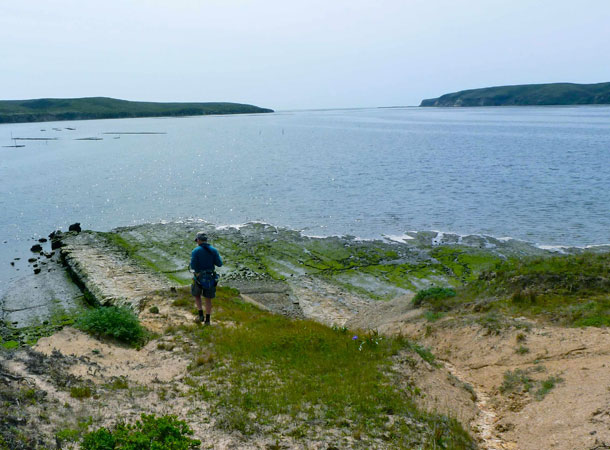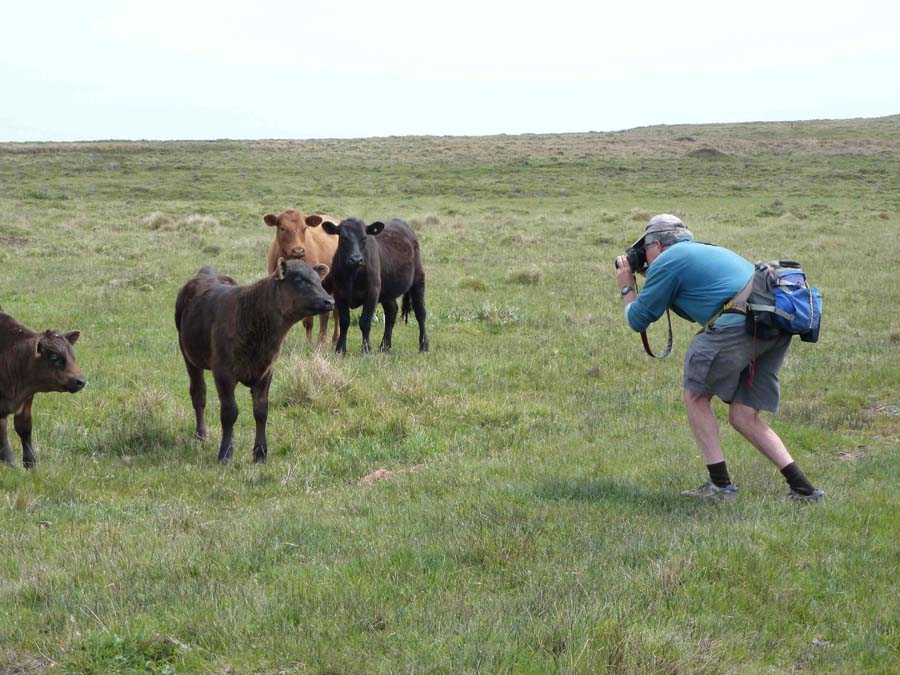Trail notes: Easy one-way path through pastureland to sandstone cliffs overlooking Drakes Estero. Several swales may be difficult to cross following rains. Distance: 1.8 miles from the parking lot trailhead to the shoreline.
Seen from the air, Drakes Estero–the largest estuary complex encompassed by the Point Reyes Peninsula–resembles a huge hand, irregularly outlined by nearly 25 miles of crenulated shoreline. The main lagoon, along with its five fingers–Barries Bay, Creamery Bay, Schooner Bay, Home Bay, and Limantour Estero–covers about 3.6 square miles at high tide. Bull Point Trail is the shortest route to a panoramic view of the “palm” of Drakes Estero.
The Bull Point trail traces a low ridge for nearly two miles across pastureland that that runs from Sir Francis Drake Boulevard southward between Creamery Bay and Schooner Bay before arriving to the headlands overlooking the estero. Many of the peninsula’s place names convey human history. Creamery and Schooner bays refer to the mid-1800s when, according to Jack Mason’s history Point Reyes: The Solemn Land, the bays were navigable and butter and hogs were loaded onto schooners for the San Francisco markets.
Over a century of cattle grazing has converted much of this rolling marine terrace from coastal prairie to annual grassland. Bovine bioengineers watch us with inscrutable stares as we traverse their rangeland.
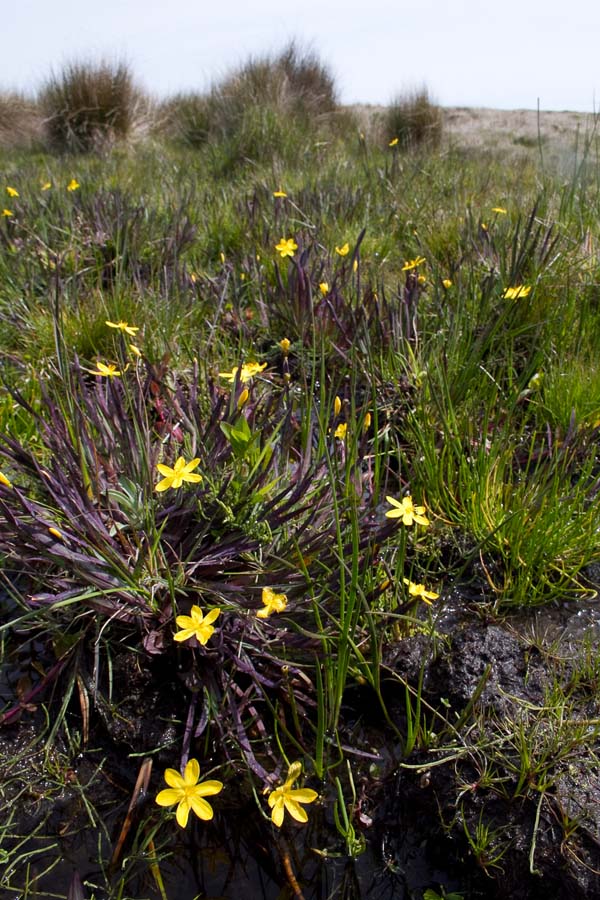
-
Yellow-eyed grass (Sisyrinchium californicum) grows in damp soils amidst rushes. Photograph by David Wimpfheimer.
It has been a dry winter, so the bloom is sparse, just a few hardy native refugees of the northern coastal prairie. Douglas irises and buttercups (Ranunculus californicus) are scattered through the grazed pasture. In damper soil along the trail, a few naked plantains (Plantego subnuda) hug the ground. We start to notice fairly profuse clusters of yellow-eyed grass in swales and rivulets fenced off from grazing. This plant’s common name is misleading; it’s not a grass, but rather a member of iris family, and it doesn’t have any eyes. However, the Latin name, Sisyrinchium californicum is more descriptive, derived from the Greek sisyra, meaning goat’s hair coat, in reference to wooly covering of the plant’s bulb.
Early April is the peak of the northward migration of sea geese called “black” brant along the Pacific Coast. In the early 1980s we conducted a region-wide brant census and counted a flock 4,700 strong stopping over in the estero to refuel on the blades of eelgrass. Each spring since I return to try to catch this migratory pulse.
From Bull Point, we scan the open water and count the brant flocks rafting on surface. This congregation is en route from traditional wintering habitat in Baja’s Bahia Magdelena or Laguna San Ignacio to breeding grounds on the Arctic tundra. We estimate 1800 geese, foraging on the submerged pastures of eelgrass (Zostera marina), chattering among themselves. During the brants’ 5,000-mile journey between their winter wetlands and their northern nesting grounds, the eelgrass fields provide their only sustenance. No other waterbird relies so heavily on a single native food plant.
As the brant is the estuary’s emblematic waterbird, so is eelgrass its emblematic plant. Not a seaweed (which are algae), but a true flowering plant, eelgrass needs sunlight and relatively clear, cool tidal water to thrive and fulfill its variety of ecological functions–creating habitat, providing shelter and spawning substrate to myriad species, and forming the basis of primary production. Eelgrass meadows are in slow but marked decline along the Pacific coast, so those in more remote, undisturbed and non-urbanized estuaries like this take on an added significance.
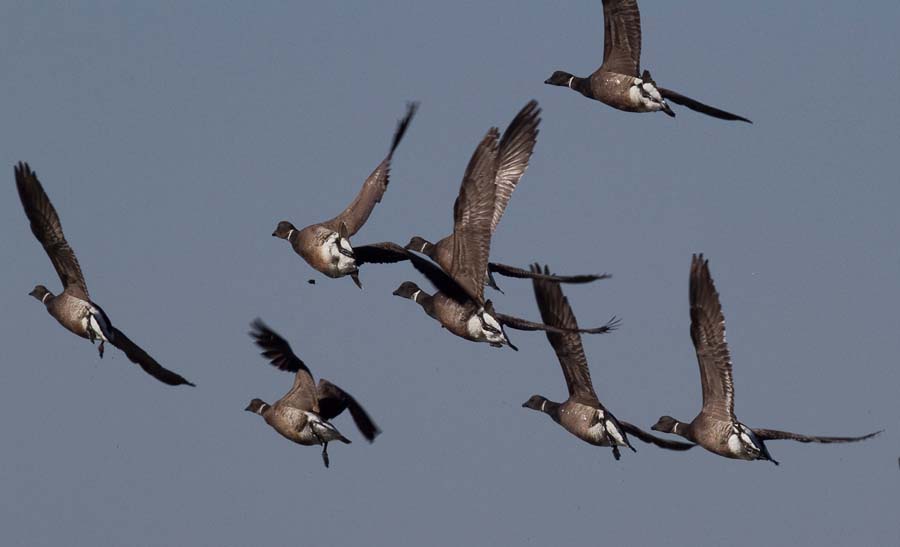
-
Black Brant (Branta bernicla). Note the white collar, a diagnostic field mark. These marine geese show fidelity to wintering and nesting sites as well as migratory “refueling stations” such as Drakes Estero. Photograph by David Wimpfheimer.
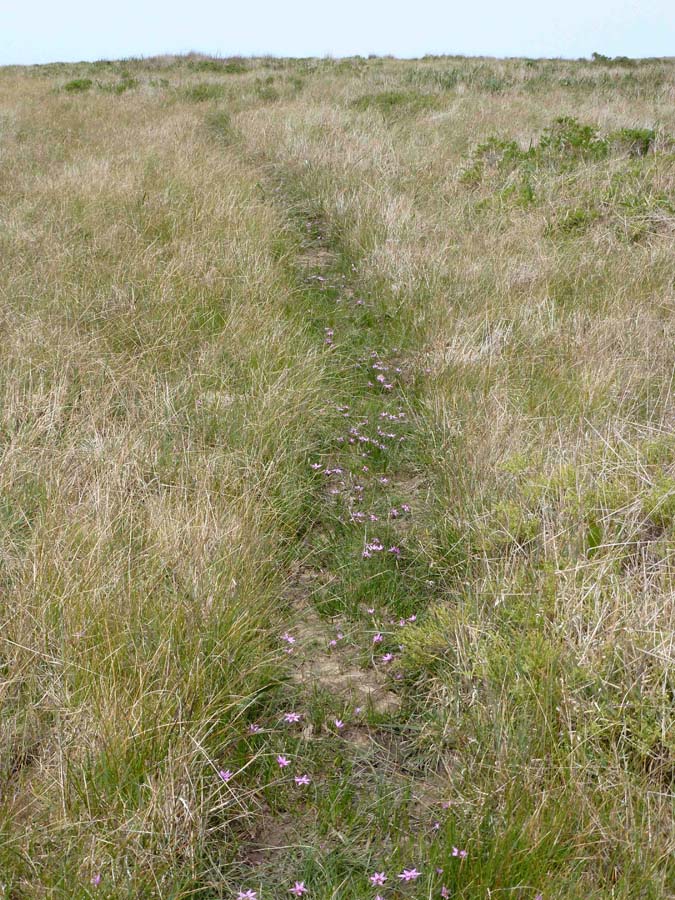
-
On the outer reaches of the Bull Point Trail, where grazing pressure is reduced, annual grasses are replaced by native bunchgrasses. Today, an abundant bloom of non-native sandcrocus (Romulea rosea var. australis) follows the compacted earth of the trail. Photograph by Jules Evens.
Brant, too, are in decline. Spring surveys have indicated a more than 50 percent decrease in use of California bays since 1950s, but it is unknown whether this decline is due to reduction in the population’s overall size, a shift in migration patterns, or a combination influences. (Ecology is not rocket science; it’s much more complicated.) One of the unavoidable liabilities of being an ecologist is bearing witness to the diminution of native flora and fauna due primarily to the insatiable appetite of humankind.
Sometimes this discontent is counterbalanced by the heartening rush felt when encountering some unexpected wild creature. As we retraced our steps from Bull Point back toward the trailhead, crossing a knoll where grazing pressure was relatively light, we flushed a little burrowing owl from its perch on a small hummock of earth outside a foxhole. It flew about 30 yards away and landed on another hummock of exposed dirt, watching us, and bobbing in place as we skirted around him, giving him enough personal space for his comfort. Unique among North American owls, this diminutive species is active during the day and nests in burrows in the ground (usually those excavated by ground squirrels). We investigated one of the pellets he’d left outside the burrow; it was composed almost entirely of the exoskeletons and elytra (hardened forewings) of ground beetles.
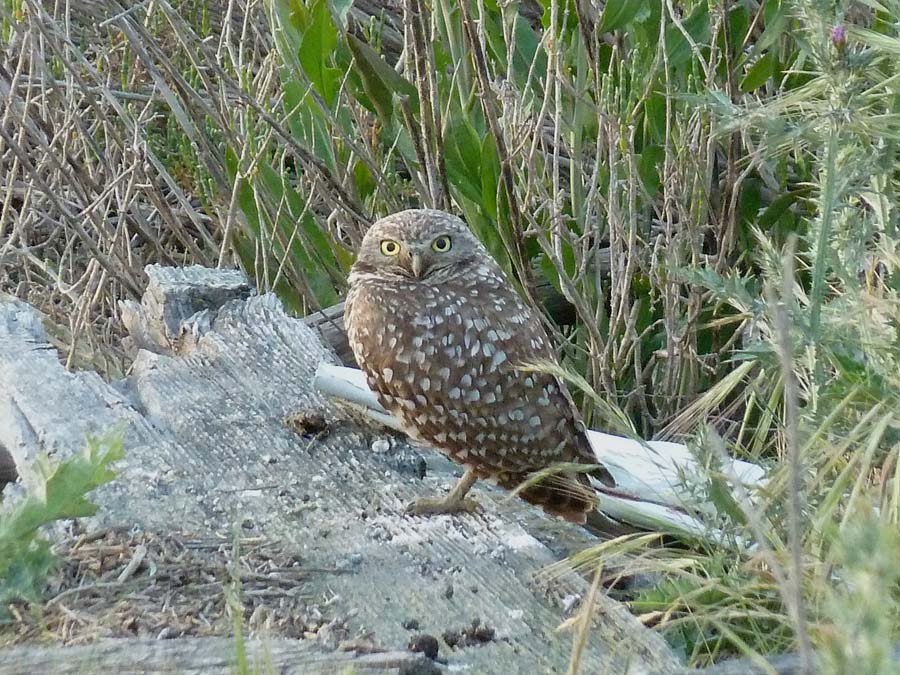
-
Burrowing owl (Athene cunicularia), a rather rare winter visitor to the immediate coast, where this little owl is usually associated with dunes, coastal strand, prairie, and grassland. Photograph by Jules Evens.
Surprised by an impish owl–even moments of delight are sometimes tempered by ecological reality. Like eelgrass and brant, burrowing owl populations have declined sharply across much of the species’ range over the past half-century. The owl is listed as a “species of conservation concern” in half of the 18 western states it still occupies. Although no one major factor has been implicated in the decline of this species, the cumulative effects of human activities–especially conversion of grasslands to urban and suburban environments–have undoubtedly taken a major toll.
“One of the penalties of an ecological education is that one lives alone in a world of wounds.” Aldo Leopold

